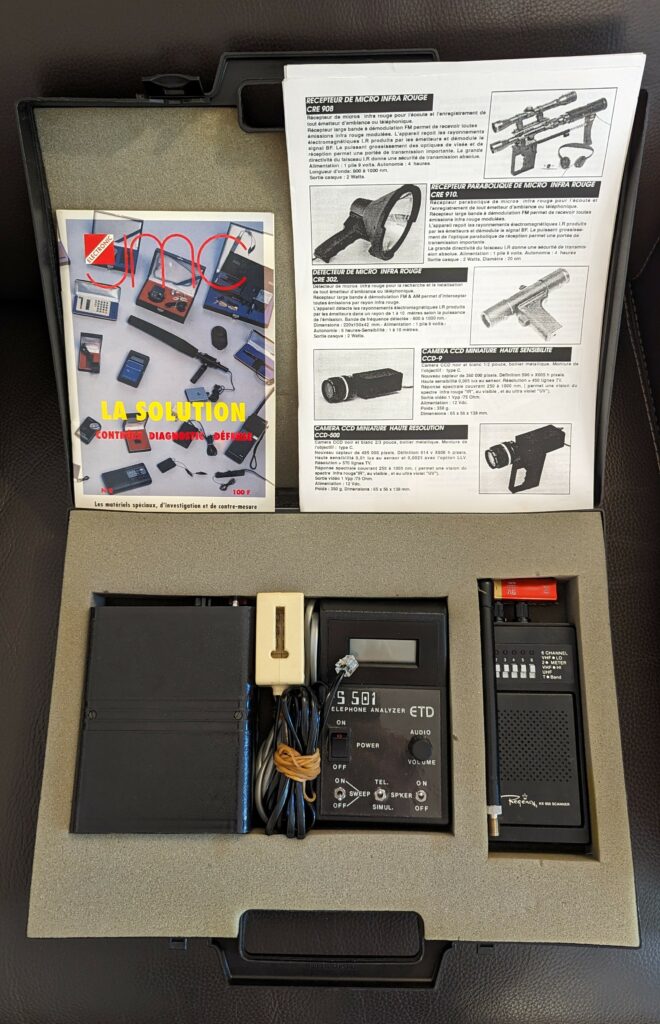Counter-listening and microphone detection
In a world where information has acquired immeasurable value, the importance of counter-surveillance and micro-detection continues to grow. Whether it’s for national security, safeguarding a company’s assets, or protecting an individual’s privacy, these tools have become indispensable to ensure the confidentiality and security of our communications.
However, to be truly effective, it is imperative to adapt and evolve with technology. This entails enlisting the services of professionals equipped with appropriate gear and staying informed about the legal and ethical implications of these practices.
Understanding Microphones
To delve into the subject fully, it is essential to first comprehend what a microphone, or “mic,” is. A microphone is a transducer device that converts sound waves into electricity. Sound waves travel through the air and are captured by the microphone, which typically employs a diaphragm (a thin membrane of sorts) that vibrates in response to these waves. These vibrations are then converted into an electrical signal that can be amplified, recorded, or transmitted.
Microphone detection is a process that involves identifying the presence of a hidden microphone in an environment. This practice typically falls within the realm of counter-espionage. Here’s how it works:
Spectral Analysis
It’s a widely used method for microphone detection. It involves analyzing electromagnetic waves in a given environment to search for anomalies that might betray the presence of a microphone.
Thermography
Another effective technique for spotting a hidden microphone is to use thermal imaging cameras to detect sources of heat. An active microphone emits heat, which can be detected using this method.
Acoustic Analysis
This final method entails emitting a high-frequency sound in a room and analyzing the echo. A hidden microphone will alter this echo, making it detectable.

What Is Counter-Surveillance?
Counter-surveillance refers to a set of techniques aimed at preventing unauthorized interception of information by third parties. Whether through phone calls, emails, instant messages, or social networks, counter-surveillance ensures the confidentiality of your exchanges. In today’s society, our personal information is precious. It can be used for targeted marketing, identity theft, opinion manipulation, or even government surveillance. That’s why counter-surveillance is so crucial – it’s the barrier protecting our privacy. There are many methods of counter-surveillance, ranging from the simplest to the most complex:
Physical Counter-Surveillance
This includes methods to detect and neutralize physical surveillance devices, such as hidden microphones and spy cameras. Physical counter-surveillance techniques may involve visual inspection, the use of signal detectors, or radio frequency scanning devices.
Digital Counter-Surveillance
With the advent of digital technology, digital counter-surveillance has become increasingly important. This can involve encrypting your communications, using VPNs to hide your online location, and using anti-malware software to protect your device from intrusions.
How to Implement Counter-Surveillance?
Setting up an effective counter-surveillance system may seem daunting, but it’s not. In fact, there are many tools and services available that can help protect your information.
Choose Secure Communication Services
Opt for communication services that offer a high level of security. These services typically employ advanced encryption techniques to protect your information from unauthorized eavesdropping.
Adopt Secure Browsing Habits
Counter-surveillance isn’t just about communications; it also extends to your online behavior. By adopting secure browsing habits, you can reduce the chances of your information being intercepted.
The Legal Aspects of Counter-Surveillance and Micro-Detection in France
Counter-surveillance, also known as communications interception, is strictly regulated in France. According to the French penal code, listening, recording, or transmitting private or confidential spoken words without the consent of the concerned person is illegal. However, exceptions exist for judicial authorities in criminal investigations, provided they obtain a judge’s authorization. Additionally, intelligence services can conduct interceptions for national security purposes, but these operations are subject to strict oversight by the National Commission for Control of Intelligence Techniques (CNCTR).
Regarding microphone detection, there is no specific law against it. The key is to consult qualified experts equipped with suitable gear to best counter the potential presence of microphones, whether in a residence or a company’s premises.
Counter-surveillance and microphone detection, despite their technical complexity and the legal dilemmas they raise, have become indispensable necessities in our contemporary society. Their existence and use are destined to evolve with technological advancements, and the best way to approach them is to stay informed and prepared.
Find the answers to the questions you ask yourself regarding the counter-listening and microphone detection
Protect yourself against industrial espionageIdentity theft: precautions to take